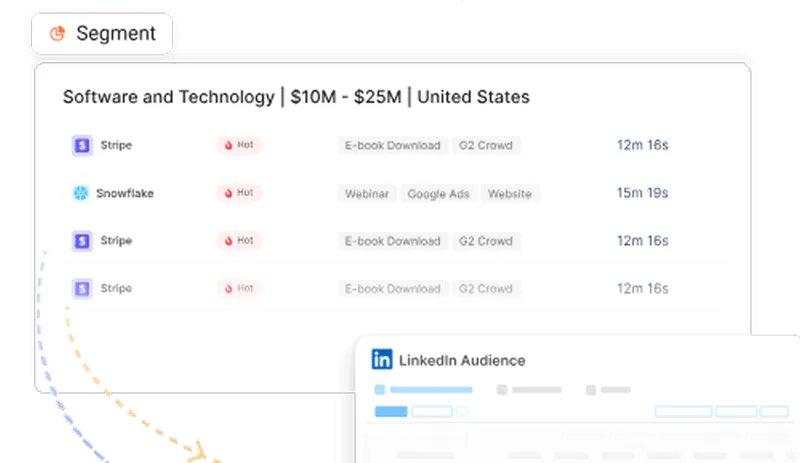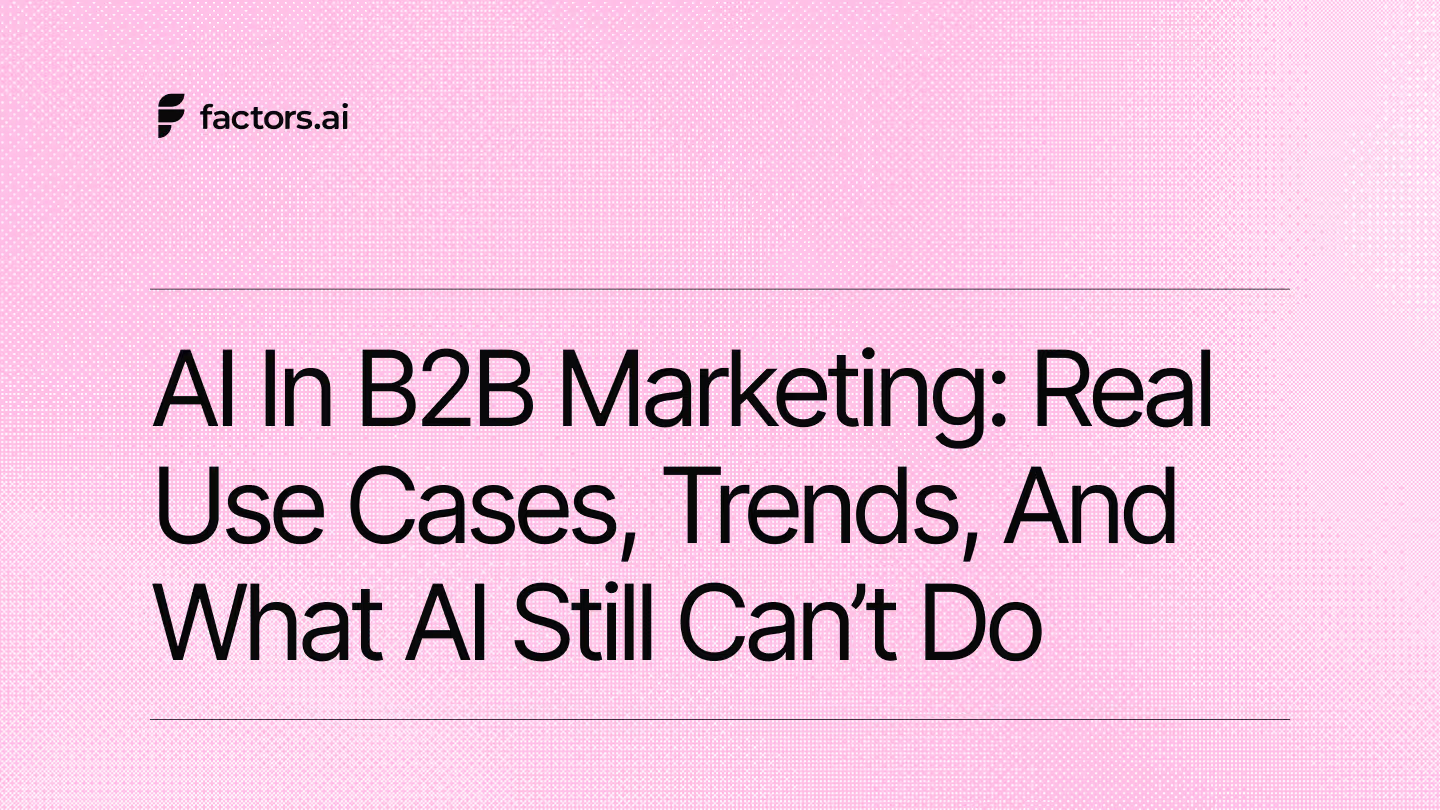How to Create a Successful B2B Paid Advertising Strategy
Discover how to build a fail-proof paid advertising strategy for your business to win revenue in 2024.
There’s no doubt that paid advertising is one of the best channels for marketing teams to generate and capture demand. Plus, we're seeing the rise of paid social media, with over 66% of B2B marketers acknowledging its impact on improving ROI. By targeting specific audiences and broadcasting your message across various channels, paid advertising can help drive the success of your campaigns.
However, running a few ads at random does not get you conversions. A strong strategy is key to maximizing ROI on expensive ads.
Let's dive in and look at how paid advertising can benefit your B2B company ⬇️
Google ads vs LinkedIn ads: Which one is best for B2B?
While many businesses advertise online, only a few do it well. It's especially tough when you have heaps of options to choose from. So, Google, LinkedIn, Search, Display, or a combination of all of the above? The choice isn't that simple, as each platform has its unique features and capabilities. In some instances, using either of the channels would be enough. For example, you should use Google Ads to target people based on their search queries, location, device, and more. LinkedIn ads can help create targeted ABM campaigns.
However, if you’re running a full-funnel campaign, you must use both Google and LinkedIn ads to their fullest potential.
Let's understand the differences between these platforms, how they work, their pros and cons, and which platform is better for your unique needs.
Google Ads
Google search ads appear when users search for specific keywords related to your business. Here are their pros and cons:
Pros of Search Ads
- Access to a larger audience when bidding on high-volume keywords
- Typically attract in-market leads as they're based on search intent
- Detailed analytics allow you to track clicks, conversions, and ROI effectively
Cons of Search Ads
- Popular keywords in B2B industries can be highly competitive, leading to higher costs per click.
- Demographic targeting is limited compared to social media platforms.
- Primarily text-based, offering less opportunity for visual branding.
- Lesser segmentation opportunities
LinkedIn Ads
LinkedIn ads target users based on their professional profiles, interests, and behavior. Here are their pros and cons:
Pros of LinkedIn Ads
- Extensive targeting options based on job title, company size, and industry, allowing precise audience segmentation.
- Ideal for B2B marketing.
- Access to high-value prospects and decision-makers
- Account-based marketing opportunities
- Offers various ad formats, like sponsored content, text ads, and InMail, providing flexibility in messaging and creative presentation
Cons of LinkedIn Ads
- Relatively costlier than Google search ads
- Cannot identify high-intent buyers unless they click on the ad
- Greater risk of ad fatigue and decreased engagement over time
- Lack of in-depth reporting and analytics tools
How to use Google ads and LinkedIn ads in tandem for a successful paid advertising strategy
While search ads and LinkedIn ads have distinct pros and cons, integrating them into a cohesive paid advertising strategy allows businesses to use each platform's strengths and increase their reach, engagement, and conversions. Here are a few ways to do so:
- Use search ads to capture users actively searching for solutions, and LinkedIn ads to raise awareness and nurture leads at different stages of the buyer's journey.
- Retarget users who interact with your LinkedIn ads through search ads and vice versa, reinforcing your messaging across platforms.
- Use data from both platforms to inform targeting and messaging strategies, optimizing performance across the board.
- Broaden your advertising channels and reduce reliance on a single platform to mitigate performance variations and adapt to algorithmic shifts.
💡Read: How to Measure LinkedIn True ROI With Factors
How to execute paid advertising across the funnel
When it comes to paid marketing, most people start with Google, which provides a decent number of quality leads by capturing searches that show intent. However, it's essential to create a well-structured funnel that attracts the right audience and converts them quickly. Instead of having countless uninterested users, it's better to have interested ones heading in the right direction.
Here's where LinkedIn retargeting helps you reach a high-intent audience from Google and target them on LinkedIn.
- Pick the right advertising channels
Consider where your ideal customers spend their time online and choose platforms with the potential to reach them. Before selecting the right platform, consider your budget and advertising goals for your paid advertising efforts. By thoughtfully selecting the right mix of channels, you can create a cohesive and effective B2B advertising strategy tailored to your unique business needs.
- Get a high-quality and high-intent audience.
When reaching an audience on LinkedIn, you have two options. You can either target a new audience or retarget an existing one. If you choose the former, you'll reach out to a completely cold audience that may not be familiar with you or your brand, making it more challenging to capture their attention. However, suppose you choose to retarget your Google ads traffic. In that case, you'll reach out to an audience that has already shown interest in your brand by searching for relevant keywords on Google, clicking on your search or display ad, and visiting your website. This audience is more likely to have high intent and be receptive to your message.
Ideally, you should invest in both options if your budget allows it. However, if you have to choose between the two, it makes more sense to retarget a warm audience that has already shown interest in your product or service.
💡Also read: Build Better LinkedIn Retargeting Audiences with Factors
- Optimize ad spend
Many clients want to establish a presence on LinkedIn but find advertising on the platform expensive. LinkedIn's cost per click (CPC) and lead (CPL) are relatively high compared to other platforms. However, the quality of leads on LinkedIn is worth the extra cost.
If you have already advertised on other channels, you can use LinkedIn to enhance your conversion rates. Different channels can add relevant leads to your LinkedIn campaigns, which can be part of your mid-funnel strategy. Proper retargeting of high-intent traffic via LinkedIn ads can lead to increased conversions.
- Convert more by staying on top of their mind
According to the marketing rule of 7, "a prospect needs to "hear" the advertiser's message at least seven times before they'll take action to buy that product or service."
A customer's journey towards making a purchase is not always straightforward. They may come across your business through a LinkedIn Ad, search for your business on Google, visit your website, leave, and stumble upon you again on LinkedIn. They may revisit your website before deciding to reach out or make a purchase. Retargeting helps push website traffic towards purchase.
💡Also read: How to Measure the Impact of Paid Marketing Using Factors
Paid advertising best practices
Paid ad campaigns are dynamic, and the right strategies can significantly impact your brand's success. To improve your efforts at online paid advertising, consider the following best practices:
1. Establish realistic goals
Having measurable goals allows you to track your progress and stay on schedule. Define your KPIs to measure lead generation, sales conversion, or brand awareness success. This will help you make informed decisions and optimize your ad spend.
2. Create compelling paid campaigns
Your ad creatives must grab the attention of your target audience. Keep them engaging, informative, and visually appealing. Avoid using jargon or complex language. Instead, focus on the value of your product and how it can solve a problem for your audience. Create a strong value proposition that highlights your unique benefits. Stand out from competitors and guide prospects to take action with a persuasive CTA.

Source: LinkedIn
3. Personalize your campaigns
Retargeting is a great way to personalize your marketing funnel for each campaign and tailor your message to the audience of that campaign.
For example, you have a search ad campaign targeting your competitors' branded keywords, which generates much interest. You can use LinkedIn and launch a retargeting campaign based on how you compare against them and what you offer that they don't. Running retargeting ads helps you identify what drives people to click and then adjust your LinkedIn ads to push them toward your offerings.
💡Factors helps you identify accounts that view your LinkedIn ads and visit your website through a search ad. You can use this information to personalize your cold outreach and focus on accounts with higher intent.
4. Measure and analyze
Track key metrics like click-through rates, conversion rates, CPA, and ROAS to make data-driven decisions. By setting campaign goals such as a target cost per lead or target conversion rate, you can track performance and analyze audience data like CTR and impressions to improve your marketing.

Rev up your paid advertising game with Factors
While search and LinkedIn ads have unique features and capacities, integrating them into a cohesive paid advertising strategy allows businesses to use each platform's strengths and increase their reach, engagement, and conversions. Companies can optimize performance across the board by using data from both platforms to inform targeting and messaging strategies.
Thanks to Factors, you can gain a comprehensive view of buyer journeys, understand how your target accounts interact with your ads and determine whether your ad strategy is increasing revenue. Speak to our team today to optimize your paid advertising strategy in 2024.
A successful B2B paid advertising strategy involves setting objectives, crafting compelling ad creatives, personalizing campaigns, and analyzing performance metrics.
1. Key Platforms: Google Ads for targeting search intent and LinkedIn Ads for targeting professional demographics.
2. Enhancing Campaigns: Tools like Factors.ai provide insights into buyer journeys, enable intent-based outreach, and optimize ad spend.
3. Strategic Benefits: Personalization, improved targeting, and better ROI through continuous optimization and data-driven decisions.
Implementing a well-rounded paid advertising strategy ensures more effective campaigns and higher returns on investment.
See how Factors can 2x your ROI
Boost your LinkedIn ROI in no time using data-driven insights


See Factors in action.
Schedule a personalized demo or sign up to get started for free
LinkedIn Marketing Partner
GDPR & SOC2 Type II
.svg)







.avif)


